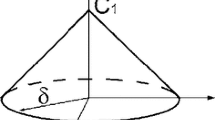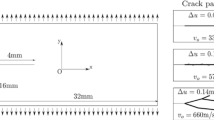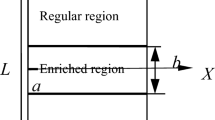Abstract
Attempts are made to analyze the temporal and spatial effect and the complex mechanical behaviors of microcracks and the macro crack at mesoscopic scale based on the damage evolution principle. The mechanism of crack curving and branching in quasi-brittle materials under dynamic biaxial loading is investigated. The effects of different ratios between the load in the horizontal and vertical directions (for convenience, the loading ratio is denoted by B in this paper), crack dip angles and material homogeneity on crack curving and branching are considered. The results indicate that: Crack curving is mainly controlled by the loading ratio, while initiation and propagation of branch microcracks are related to the stress level. The initial dip angle of crack can vary the stress configuration at the crack tip zone. If the loading ratio remains constant, the crack tends to propagate toward the vertical direction with increasing crack dip angle. It is also found that heterogeneity due to defects in the material play an important role in the distribution of tiny voids and cracks in the material and the crack propagation mode. The results in this study are not only in good agreement with the physical test results, but also can provide some valuable reference for studies on the tensile properties and failure modes of heterogeneous quasi-brittle materials with internal defects.
Similar content being viewed by others
References
Andersons J, Leterrier Y, Fescenko I (2003) Analysis of the initial fragmentation stage of oxide coatings on polymer substrates under biaxial tension. Thin Solid Films 434(1–2): 203–215
Bhat HS, Biegel RL, Rosakis AJ, Sammis CG (2010) The effect of asymmetric damage on dynamic shear rupture propagation II: With mismatch in bulk elasticity. Tectonophysics 493(3–4): 263–271
Biegel RL, Bhat HS, Sammis CG, Rosakis AJ (2010) The effect of asymmetric damage on dynamic shear rupture propagation I: no mismatch in bulk elasticity. Tectonophysics 493(3–4): 254–262
Bowden FP, Brunton JH, Field JE, Heyes AD (1967) Controlled fracture of brittle solids and interruption of electrical current. Nature 216: 38–42
Budiansky B (1982) Micromechanics. Comput Struct 16(1): 3–12
Buehler MJ, Gao H (2006) Dynamical fracture instabilities due to local hyperelasticity at crack tips. Nature 439(7074): 307–310
Buehler MJ, Abraham FF, Gao H (2003) Hyperelasticity governs dynamic fracture at a critical length scale. Nature 426(6963): 141–146
Chapman TC, Rose TA, Smith PD (1995) Blast wave simulation using AUTODYN2D: a parametric study. Int J Impact Eng 16(5–6): 777–787
Chen ZH, Tang CA, Fu YF (1998) Infinite element simulation of catastrophe induced by evolution of rock microfracturing damage. Chin J Geotech Eng 20(6): 9–15 (in chinese)
Fineberg J, Gross SP, Marder M, Swinney HL (1992) Instability in the propagation of fast cracks. Phys Rev B 45(10): 5146
Grange S, Forquin P, Mencacci S, Hild F (2008) On the dynamic fragmentation of two limestones using edge-on impact tests. Int J Impact Eng 35(9): 977–991
Ha YD, Bobaru F (2011) Characteristics of dynamic brittle fracture captured with peridynamics. Eng Fract Mech 78(6): 1156–1168
Hawong J, Kobayashi A, Dadkhah M, Kang B, Ramulu M (1987) Dynamic crack curving and branching under biaxial loading. Exp Mech 27(2): 146–153
Huang ML, Tang CA, Zhu WC (2000) Numerical simulation on failure process of rock. Chin J Geotech Eng 19(4): 468–471 (in chinese)
Krauthammer T, Otani RK (1997) Mesh, gravity and load effects on finite element simulations of blast loaded reinforced concrete structures. Comput Struct 63(6): 1113–1120
Leterrier Y, Pellaton D, Mendels D, Glauser R, Andersons J, Månson JaE (2001) Biaxial fragmentation of thin silicon oxide coatings on poly(ethylene terephthalate). J Mater Sci 36(9): 2213–2225
Liang ZZ, Tang CA, Zhang Yb, Ma TH (2008) On probability model of physico-mechanical parameters of quasi-brittle materials and associated mechanical failure behaviors. Chin J Rock Mech Eng 27(4): 718–727 (in Chinese)
Luccioni B, Ambrosini D, Danesi R (2006) Blast load assessment using hydrocodes. Eng Struct 28(12): 1736–1744
Mazars JM, Pijaudieer-Cabot G (1989) Continuum damage theory-application to concrete. J Eng Mech 115(2): 345–365
Mello M, Bhat HS, Rosakis AJ, Kanamori H (2010) Identifying the unique ground motion signatures of supershear earthquakes: theory and experiments. Tectonophysics 493(3–4): 297–326
Pollard DD, Griffith WA (2009) Laboratory investigation of damage by tensile fracture during dynamic shear rupture propagation. Department of Geological and Environmental Science, Stanford University, Stanford, pp 1–24
Rafiee S, Seelig T, Gross D (2003) Simulation of dynamic crack curving and branching under biaxial loading by a time domain boundary integral equation method. Int J Fract 120: 545–561
Ravi-Chandar K, Knauss WG (1984) An experimental investigation into dynamic fracture: I. Crack initiation and arrest. Int J Fract 25(4): 247–262
Ravi-Chandar K, Knauss WG (1984) An experimental investigation into dynamic fracture: II. Microstructural aspects. Int J Fract 26(1): 65–80
Ravi-Chandar K, Knauss WG (1984) An experimental investigation into dynamic fracture: III. On steady-state crack propagation and crack branching. Int J Fract 26(2): 141–154
Ravi-Chandar K, Yang B (1997) On the role of microcracks in the dynamic fracture of brittle materials. J Mech Phys Solids 45(4): 535–563
Rice JR, Guo GF (2001) New perspectives on crack and fault dynamics. Adv Mech 03: 447–460 (in chinese)
Rossmanith HP, Fourney WL (1982) Fracture initiation and stress wave diffraction at cracked interfaces in layered media. I. Brittle/brittle transition. Rock Mech Rock Eng 14(4): 209–233
Schlangen E, Mier JGMV (1992) Experimental and numerical analysis of micromechanisms of fracture of cement-based composites. Cement Concrete Composit 14(2): 105–118
Sharon E, Fineberg J (1996) Microbranching instability and the dynamic fracture of brittle materials. Phys Rev B 54(10): 7128
Sharon E, Fineberg J (1999) Confirming the continuum theory of dynamic brittle fracture for fast cracks. Nature 397(6717): 333–335
Shi Y, Li Z, Hao H (2008) Mesh size effect in numerical simulation of blast wave propagation and interaction with structures. Trans Tianjin Univ 14(6): 396–402
Suzuki S, Sakaue K, Iwanaga K (2007) Measurement of energy release rate and energy flux of rapidly bifurcating crack in Homalite 100 and Araldite B by high-speed holographic microscopy. J Mech Phys Solids 55(7): 1487–1512
Tang C (1997) Numerical simulation of progressive rock failure and associated seismicity. Int J Rock Mech Min 34(2): 249–261
Tang CA, Kaiser PK (1998) Numerical simulation of cumulative damage and seismic energy release during brittle rock failure—part I: fundamentals. Int J Rock Mech Min 35(2): 113–121
Tang CA, Liu H, Lee PKK, Tsui Y, Tham LG (2000a) Numerical studies of the influence of microstructure on rock failure in uniaxial compression—part I: effect of heterogeneity. Int J Rock Mech Min 37(4): 555–569
Tang CA, Tham LG, Lee PKK, Tsui Y, Liu H (2000b) Numerical studies of the influence of microstructure on rock failure in uniaxial compression—part II: constraint, slenderness and size effect. Int J Rock Mech Min 37(4): 571–583
Tang CA, Zhu WC (2003) Damage and fracture of concrete-numerical tests. Science Press, Beijing (in Chinese)
Weibull W (1951) A statistical distribution function of wide applicability. J Appl Mech 18(3): 293–297
Zhou F, Molinari J-F, Shioya T (2005) A rate-dependent cohesive model for simulating dynamic crack propagation in brittle materials. Eng Fract Mech 72(9): 1383–1410
Zhu BF (1998) Principle and application of finite element methods. 2nd edn. China Water Power Press, Beijing
Zhu WC, Tang CA (2006) Numerical simulation of Brazilian disk rock failure under static and dynamic loading. Int J Rock Mech Min 43(2): 236–252
Zhu WC, Tang CA, Yang TH, Liang ZZ (2003) Constitutive relationship of mesoscopic elements used in Rfpa2D and its validations. Chin J Rock Mech Eng 22(1): 24–29 (in Chinese)
Zhu WC, Pang MZ, Huang ZP, Tang CA (2006) Numerical simulation on dynamic rock spalling. J Northeastern Univ 5: 552–555 (in Chinese)
Author information
Authors and Affiliations
Corresponding author
Rights and permissions
About this article
Cite this article
Yang, Y.F., Tang, C.A. & Xia, K.W. Study on crack curving and branching mechanism in quasi-brittle materials under dynamic biaxial loading. Int J Fract 177, 53–72 (2012). https://doi.org/10.1007/s10704-012-9755-6
Received:
Accepted:
Published:
Issue Date:
DOI: https://doi.org/10.1007/s10704-012-9755-6




